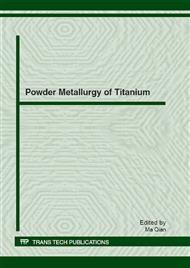p.289
p.295
p.301
p.309
p.314
p.320
p.330
p.335
p.341
Weldability of Ti-6Al-4V Alloys Formed via Various Powder Consolidation Techniques
Abstract:
This study considers the weldability of Ti-6Al-4V alloys formed by various powder consolidation methods. Samples were prepared from commercially sourced pre-alloyed Ti-6Al-4V powder using both conventional press-and-sinter (PS) and the new novel resistance-heated pressing (RHP) methods. Fusion welding was executed by the gas tungsten arc (GTA) process with arc stability assessed in-situ by observations of the arc as well as monitoring of transient arc voltage. Results indicated equivalent arc stability between samples of RHP and commercially sourced wrought material while samples formed by PS showed high instability in arc initiation, attributed to high levels of porosity. Post weld analysis of mechanical hardness in powder based samples revealed no significant deviation in weld metal properties from welds conducted on commercially sourced wrought material. In all cases weld microstructures typical of Ti-6Al-4V alloys were observed with significant grain growth in the fusion and heat affected zones. Samples prepared by PS methods showed internal porosity due to gas evolution upon solidification, which may again be attributed to the highly porous initial microstructure.
Info:
Periodical:
Pages:
314-319
Citation:
Online since:
August 2012
Keywords:
Price:
Сopyright:
© 2012 Trans Tech Publications Ltd. All Rights Reserved
Share:
Citation:


